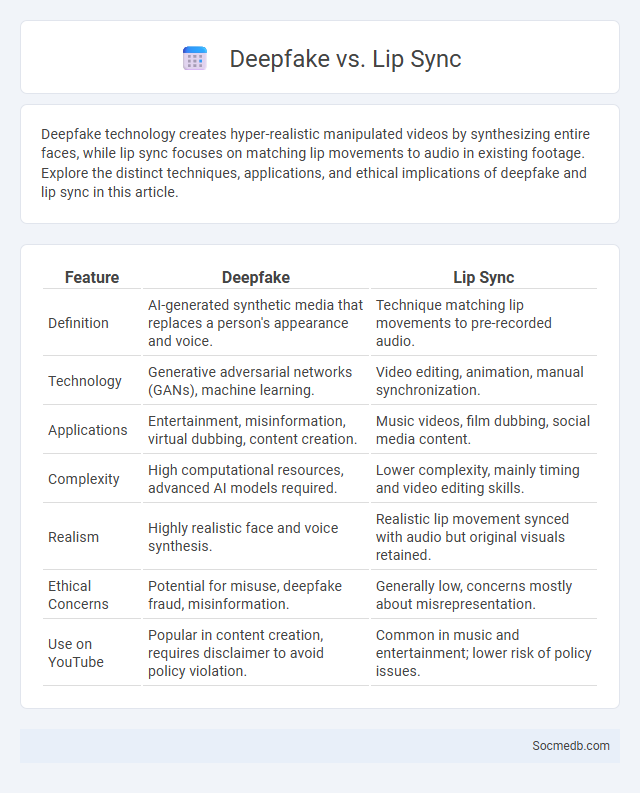
Photo illustration: Deepfake vs Lip Sync
Deepfake technology creates hyper-realistic manipulated videos by synthesizing entire faces, while lip sync focuses on matching lip movements to audio in existing footage. Explore the distinct techniques, applications, and ethical implications of deepfake and lip sync in this article.
Table of Comparison
| Feature | Deepfake | Lip Sync |
|---|---|---|
| Definition | AI-generated synthetic media that replaces a person's appearance and voice. | Technique matching lip movements to pre-recorded audio. |
| Technology | Generative adversarial networks (GANs), machine learning. | Video editing, animation, manual synchronization. |
| Applications | Entertainment, misinformation, virtual dubbing, content creation. | Music videos, film dubbing, social media content. |
| Complexity | High computational resources, advanced AI models required. | Lower complexity, mainly timing and video editing skills. |
| Realism | Highly realistic face and voice synthesis. | Realistic lip movement synced with audio but original visuals retained. |
| Ethical Concerns | Potential for misuse, deepfake fraud, misinformation. | Generally low, concerns mostly about misrepresentation. |
| Use on YouTube | Popular in content creation, requires disclaimer to avoid policy violation. | Common in music and entertainment; lower risk of policy issues. |
Introduction to Deepfake and Lip Sync Technologies
Deepfake and lip sync technologies use advanced artificial intelligence and machine learning algorithms to create hyper-realistic videos by altering facial expressions and syncing speech with manipulated visuals. These innovations pose significant challenges to authenticity verification on social media platforms, often blurring the line between genuine and fabricated content. You must stay informed about these technologies to critically evaluate the media you encounter and safeguard your digital experience.
What Is Deepfake? Understanding the Basics
Deepfake technology uses artificial intelligence to create hyper-realistic but fake videos or images, often swapping faces or altering voices with uncanny accuracy. By manipulating visual and audio content through algorithms like deep learning, deepfakes can deceive viewers and pose significant challenges to digital security and authenticity. Understanding the basics of deepfake helps you recognize manipulated media and protect your online presence from misinformation or identity misuse.
The Science Behind Lip Sync Technology
Lip sync technology in social media relies on advanced algorithms that analyze facial movements and audio signals to synchronize speech with visual lip motion accurately. Machine learning models, particularly deep neural networks, process video frames to detect and replicate lip patterns in real-time, enhancing user engagement by creating seamless audiovisual content. This technology underpins popular platforms like TikTok and Instagram, driving trends and enabling creative expression through precise audio-visual synchronization.
Key Differences: Deepfake vs Lip Sync
Deepfake technology uses advanced AI algorithms to create hyper-realistic video or audio manipulations, altering faces and voices to convincingly impersonate individuals on social media platforms. Lip sync techniques focus primarily on matching existing audio with different facial movements, often used for entertainment or creative purposes without altering the speaker's identity. Understanding these key differences helps you identify authentic content and protect your online presence from potential misinformation or fraud.
Overlapping Applications of Deepfake and Lip Sync
Deepfake and lip sync technologies share overlapping applications in social media, enabling users to create highly realistic video content by manipulating facial expressions and syncing audio with lip movements. These advancements enhance entertainment, marketing, and personalized communication by allowing your content to appear more engaging and authentic. Social media platforms increasingly combat misuse by developing AI-driven detection tools to preserve user trust and platform integrity.
Benefits and Limitations of Deepfake
Deepfake technology revolutionizes social media by enabling hyper-realistic video and audio content creation, enhancing storytelling and entertainment experiences. You gain opportunities for creative expression, personalized marketing, and innovative communication, but must remain cautious of misinformation, privacy risks, and potential for identity theft. Ethical use and critical engagement are essential to balance the benefits with the challenges deepfakes present across digital platforms.
Pros and Cons of Lip Sync Technology
Lip sync technology enhances social media content by allowing users to create engaging and entertaining videos that synchronize perfectly with popular songs or dialogues. You benefit from increased creativity and audience interaction, but risks include potential copyright issues and the perpetuation of unrealistic lip movement expectations. Balancing these pros and cons is essential for maximizing the positive impact of lip sync tools in your social media presence.
Ethical Implications and Concerns
Social media platforms raise significant ethical concerns related to user privacy, data security, and misinformation dissemination. The misuse of personal data and algorithmic biases can lead to discrimination and manipulation, impacting individual rights and societal trust. Addressing these ethical challenges requires transparent policies, robust data protection measures, and enhanced digital literacy to foster responsible use of social media technologies.
Real-World Examples: Deepfake vs Lip Sync
Deepfake technology is exemplified by realistic videos where actors' faces are convincingly swapped, such as the viral Jordan Peele Barack Obama PSA, highlighting risks in misinformation. Lip sync tools, popularized by platforms like TikTok, allow users to match their mouth movements to pre-recorded audio, driving viral dance challenges and entertainment trends. These technologies demonstrate contrasting impacts: deepfakes challenge authenticity in news and politics, while lip sync fosters creative user engagement.
Future Trends in Video and Audio Manipulation Technologies
Future trends in video and audio manipulation technologies in social media are driven by advancements in artificial intelligence and deep learning algorithms, enabling more sophisticated deepfake creation and real-time voice synthesis. Enhanced tools for automated content editing and immersive augmented reality filters will transform user-generated content, increasing engagement and personalization across platforms like TikTok, Instagram, and YouTube. These evolving technologies raise critical challenges for content authenticity verification and digital security, prompting the development of more robust detection frameworks and regulatory policies.
 socmedb.com
socmedb.com